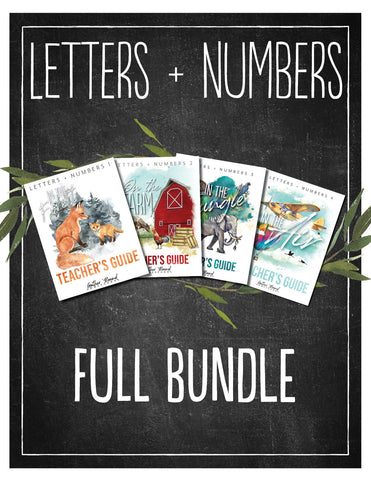Gather 'Round is known for its unit studies that can be used with all grade levels. However, young learners need sequential instruction in math and reading that can't be included in Gather 'Round's units, so they have produced two programs for beginning students.
Letters + Numbers and Ready to Read are both complete, standalone programs that cover language arts, math, Bible, science, social studies, and art. While they are designed in a unit-study fashion with themes running through the programs, they teach beginning reading and math skills in a sequential fashion.
These courses spend more time on basic skills for math and phonics than on science, social studies, and art in comparison to Gather 'Round's other unit studies. They provide very comprehensive coverage for math and language arts, including handwriting. The amount of Christian content is also significant—similar to that in Gather 'Round's unit studies.
Letters + Numbers is designed to be a preschool program, while Ready to Read is for kindergarten and first grade. Letters + Numbers teaches children to read and write all of the letters and numbers up to 20. Children also learn the sounds of letters, and they begin to read words with short-vowel sounds. (Children might need longer to learn some of these skills, so don't worry if you are using Letters + Numbers with a kindergartner.)
Ready to Read gradually teaches phonics and reading skills across the four thematic units of this course. It continues with the other phonetic concepts not taught in Letters + Numbers, including more advanced phonograms, such as those that make the sounds /oi/ and the different pronunciations of g and ow. Children also learn some sight words to help them begin to read interesting material. This course can be spread out over two years. For language arts, children also learn to write complete sentences and learn about question marks, exclamation points, and quotation marks. In math, they learn to add and subtract. For example, in the fourth unit, they are asked to solve the problem 36 + 42. Ready to Read covers much more than the concepts I have listed, reflecting a typical kindergarten and first-grade scope and sequence. The courses are not labeled for particular levels, so you can use them when they are appropriate for each child.
Both courses have lessons for four days per week. Letters + Numbers has 208 lessons for 52 weeks while Ready to Read has 144 lessons for 36 weeks. You can see that Letters + Numbers might take more than one school year to complete, even if you do lessons five days per week.
Each of these courses is presented in four separate, themed units. Each unit has a teacher guide and one or more student books. Because instruction is sequential, students who have already covered concepts taught in a unit can skip that unit and begin with the next.
Flashcards, cutouts (including math manipulatives), and math visual aids are included at the back of the student books. Mini-books for reading practice are assembled from lesson pages in some of the student books. There are lots of cutting, pasting, and assembling activities in these two courses! (The optional Expansion Pack for Letter + Numbers provides you with some items already preassembled.)
The lesson material presented from the teacher guides covers more of the science, social studies, and Bible content while the student books are where you find most of the math and language arts instruction and activities. Lessons vary with different formats and types of activities. You will generally spend about five to fifteen minutes presenting lesson material from the teacher guide and another 10 to 30 minutes each day guiding children through the student workbook pages. Of course, you will occasionally also do art, life skill activities, field trips, or other things that take extra time.
Young children need individual attention as they work through these lessons, so they require one-on-one teaching. But the course content should be enjoyable to teach with its mixture of fascinating information for science and social studies, frequent Bible connections, and weekly art activities, intermixed with the math and language arts.
While these courses can be used on their own, Gather 'Round's regular unit studies include pre-reader level student notebooks. If you want young children to participate in those unit studies with older siblings, the pre-reader notebooks allow you to do that without overwhelming young learners. Younger students can sit in on your presentations to older children, perhaps completing one of the coloring pages in their notebooks. They do not need to listen in if the subject matter is over their heads or if they've just had too much instruction for the day. While the coloring pages and illustrations tie directly to the unit-study topics whenever possible, pre-readers are not given assignments or questions on the material.
Summary
Whether or not you use Gather 'Round's unit studies, these programs for prekindergarten through first grade can be used on their own. They do a great job of applying a unit study approach that includes reading and math.








